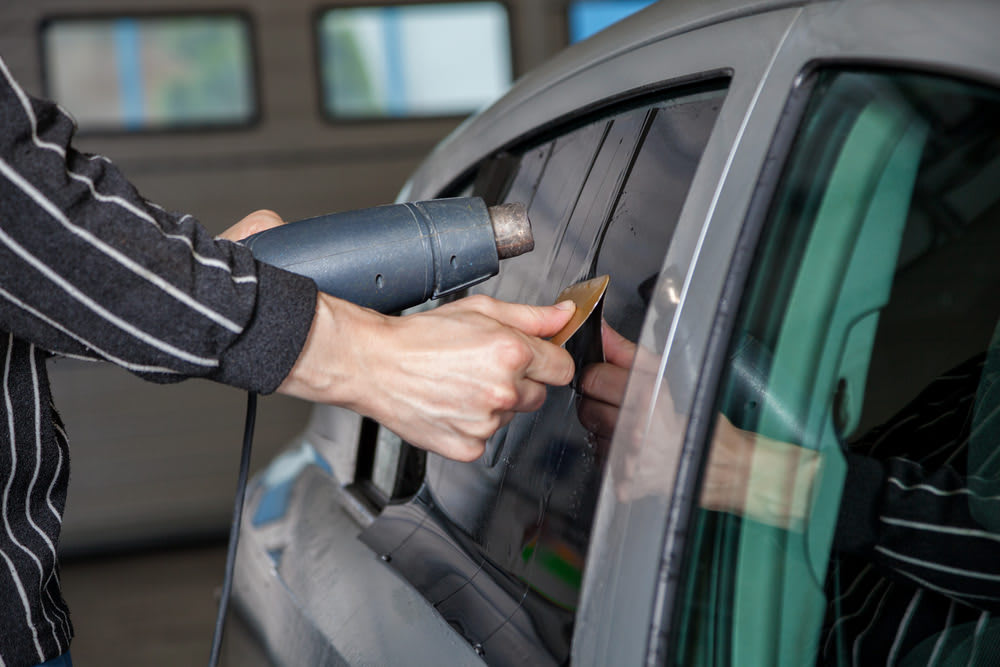

Types of Window Tint
Some vehicle manufacturers have windows that come with a factory tint on the vehicle's windows, though that is generally only done on the rear windows. This “factory tint” is done by dying the glass. There is sometimes a degree to which the top of the front window is tinted to help reflect the sun's glare. This is especially apparent on older vehicles with stock windshields, as the graduated green strip is clearly visible.
As an aftermarket upgrade, window tinting is generally done by applying a film to the interior of the vehicle’s windows. While DIY kits are available, the results can be messy, with air bubbles or crooked placement. Window tinting on a vehicle reduces the Visible Light Transference (VLT), and window tinting is graded on the percentage of light that transfers. The lower the percentage of light transmittance, the darker the tint.
Legality of aftermarket window tinting
Each state has different window tinting laws regarding the darkness of the tint legally allowed. You can check the Federal Motor Carrier Safety Administration website to find the legal tint in your state. Laws vary widely, from 20% in New Mexico to 70% in some states, including Alaska, Vermont, and Michigan. Factory tint generally has a VLT of 74-85%.
Why people tint vehicle windows
There are many good reasons to do an aftermarket tint to a vehicle’s windows. For many vehicle owners, privacy is an issue. Depending on the VLT level of tint there is the ability to make it hard for a driver to see in another vehicle's windows. Window tinting also blocks up to 99% harmful UV rays, which helps to keep the interior in better shape. Over time, this makes a significant difference in the value of the vehicle, as those with tinted windows tend to have less cracks in leather and less fading of dashboards.
Window tinting also reduces heat in the vehicle up to 70%, which is helpful for drivers who live in high heat climates such as the south. Another helpful byproduct of window tinting is it helps keep glass from shattering during an accident. While the windows of newer cars are all tempered or laminated, reducing the likelihood of sharp pieces cutting an occupant, the adhesive in window tint may result in fewer loose pieces of glass after the window is broken.
The process of window tinting
There are two options when considering aftermarket tint for a vehicle’s windows. The first is OEM tinted glass, which has the tint mixture added into the glass in manufacturing. This makes it more likely to pass even the most stringent state window tinting laws as it is a light tint. This is the most costly window tint as it needs to be done by the dealership when the vehicle is purchased, or by a licensed mechanic after the new windows are purchased.
Film tint is perhaps the most popular option. With this window tint, the window glass needs to be specially treated before a polymer film is spread over the window. Attached carefully, this form of window tinting is prone to bubbles so it is best to have a trained professional do it. The film tint is supposed to be changed every five years or so to prevent cracking and peeling.
Breakdown of Different Levels of Tint
Which method of window tinting a vehicle owner chooses is partially determined by how dark the tint should be. Each method produces a different VLT. Which one a driver chooses could be decided by factors such as the reason for tinting, and what percentage of VLT is legal in their state.
Factory Tint: The VLT of factory tint is 74-85%, depending on where the car is originally shipped for sale. This tint is applied by dying the glass, prior to sale.
OEM Tint: OEM tint can be ordered to be any VLT that’s desired, but may be subject to the applicable laws in the state where it’s ordered. OEM tint is generally an upgrade that’s done in European countries. OEM tint is applied by adding a mixture to the glass during manufacturing.
Film Tint: Film tint can be purchased with a VLT as high as 90%, or as low as 2.5%. Film tint is installed by a licensed mechanic.
Why You Should Care About Window Tinting
Tinting windows may or may not help with the resale of a vehicle. It depends on if the tint was done early enough in the ownership of the car to protect the interior, which is a primary consideration for someone looking to purchase a used vehicle. It also depends on if the tint is legal in the state that the purchaser lives in. Another consideration was the method used to tint the windows. If a DIY tint has lots of bubbles or looks shoddy, it’s not going to be perceived as an asset. Lastly, it comes down to personal preference of the buyer. While the current owner of the vehicle might have loved the aftermarket tint, a prospective buyer might not. It is important to note that neither Kelley Blue Book or Edmunds list window tint in their estimates of car sale values.



